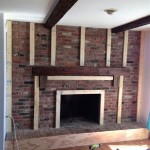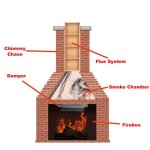Tile Fireplace Designs: A Comprehensive Guide
Fireplaces serve as focal points in living spaces, offering warmth and aesthetic appeal. Tile fireplaces elevate this function by introducing a diverse range of design possibilities, allowing homeowners to tailor the fireplace to their specific style preferences and complement the overall interior design scheme. This article explores the various aspects of tile fireplace designs, encompassing different tile types, design considerations, and installation factors.
Tile Types for Fireplaces
The selection of tile for a fireplace is a critical decision, influenced by factors such as heat resistance, durability, aesthetics, and budget. Numerous tile options are available, each possessing unique characteristics that contribute to the overall design and performance of the fireplace.
Ceramic Tile: Ceramic tile is a popular choice for fireplace surrounds due to its availability in a wide array of colors, patterns, and sizes. It is relatively affordable and easy to maintain. However, not all ceramic tiles are suitable for fireplace applications. It is essential to select tiles specifically rated for high-temperature resistance to prevent cracking or damage from the heat generated by the firebox. Glazed ceramic tiles are typically more resistant to staining and moisture than unglazed options.
Porcelain Tile: Porcelain tile, a denser and more durable type of ceramic, offers superior heat resistance and water impermeability. This makes it an excellent choice for fireplaces, particularly in areas prone to moisture or where spills are likely to occur. Porcelain tiles are available in various finishes, including matte, polished, and textured, providing diverse design options. They can also mimic the appearance of natural stone or wood, offering the aesthetic benefits of these materials with increased durability and lower maintenance.
Natural Stone Tile: Natural stone tiles, such as granite, marble, slate, and travertine, impart a sense of luxury and sophistication to a fireplace surround. Each type of stone possesses unique veining, color variations, and textures, contributing to a distinctive and natural aesthetic. Granite is known for its exceptional durability and heat resistance, making it a suitable choice for areas directly exposed to high temperatures. Marble, while visually appealing, is more porous and susceptible to staining, requiring sealing and regular maintenance. Slate offers a rustic and textured appearance, while travertine features a distinctive pitted surface. The selection of natural stone tile should consider both aesthetic preferences and the specific properties of each stone type.
Glass Tile: Glass tile offers a contemporary and visually striking option for fireplace designs. It is available in various colors, shapes, and sizes, allowing for intricate and customizable patterns. Glass tile reflects light effectively, enhancing the brightness and visual appeal of the fireplace area. While glass tile is not as heat-resistant as ceramic or porcelain tile, it can be used effectively in areas away from direct flame contact or with proper heat shielding. Specialized heat-resistant glass tiles are also available for applications requiring higher temperature resistance. Installation requires careful attention to detail to ensure proper adhesion and grout application.
Metal Tile: Metal tiles, such as stainless steel, copper, or bronze, introduce a modern and industrial aesthetic to fireplace designs. They are durable, heat-resistant, and easy to clean. Metal tiles can be used as accents or to cover the entire fireplace surround, creating a bold and dramatic statement. They are available in various finishes, including brushed, polished, and textured, allowing for customization to suit different design styles. Metal tiles require careful installation to prevent scratching or damage during the process.
Design Considerations for Tile Fireplaces
Beyond the selection of tile type, several design considerations play a crucial role in creating a visually appealing and functional tile fireplace. These considerations encompass the overall style, color scheme, tile pattern, and the integration of the fireplace with the surrounding space.
Style and Ambiance: The design of the tile fireplace should complement the overall style and ambiance of the room. A traditional fireplace design might incorporate natural stone tiles with intricate detailing, while a modern design might feature sleek porcelain tiles with minimalist patterns. The color scheme should harmonize with the surrounding walls, furniture, and décor. Neutral tones, such as beige, gray, or white, create a timeless and versatile backdrop, while bolder colors can be used to create focal points and add visual interest. The texture of the tile can also contribute to the overall ambiance. Smooth, polished tiles create a modern and sophisticated feel, while textured tiles add warmth and character.
Tile Pattern and Layout: The tile pattern and layout can significantly impact the visual appeal of the fireplace. Common tile patterns include subway tile, herringbone, mosaic, and stacked bond. Subway tile, a classic and versatile option, features rectangular tiles arranged in a staggered pattern. Herringbone, a more intricate pattern, involves arranging rectangular tiles in a V-shaped configuration. Mosaic tiles, consisting of small tiles arranged on a mesh backing, allow for intricate and customizable designs. Stacked bond, a simple and modern pattern, involves aligning tiles in a straight line. The choice of tile pattern should consider the size and shape of the fireplace, as well as the desired aesthetic. Larger tiles can create a more streamlined and modern look, while smaller tiles offer greater detail and complexity.
Fireplace Surround and Mantle: The fireplace surround and mantle provide additional opportunities for design customization. The surround, the area immediately surrounding the firebox, can be clad in tile to create a cohesive and visually appealing transition. The mantle, a shelf above the fireplace, can be used to display decorative items, such as artwork, photographs, or candles. The material and style of the mantle should complement the tile design and the overall aesthetic of the room. Wood mantles offer a traditional and warm feel, while stone or metal mantles provide a more modern and contemporary look.
Integration with Surrounding Space: The tile fireplace should be seamlessly integrated with the surrounding space. Consider the scale and proportions of the fireplace in relation to the room size. A large fireplace in a small room may feel overwhelming, while a small fireplace in a large room may appear insignificant. The fireplace should be visually balanced and proportionate to the other elements in the room. The lighting around the fireplace can also enhance its visual appeal. Recessed lighting, sconces, or spotlights can be used to highlight the tile design and create a warm and inviting ambiance.
Installation Considerations for Tile Fireplaces
Proper installation is crucial for ensuring the longevity, safety, and aesthetic appeal of a tile fireplace. Careful planning, preparation, and execution are essential for achieving a professional and durable result. It's highly recommended to hire a qualified and experienced tile installer for this project.
Surface Preparation: The surface to which the tile will be applied must be clean, level, and structurally sound. Remove any existing wall coverings, such as paint or wallpaper, and repair any cracks or imperfections. A cement board backer is typically installed over the existing surface to provide a stable and moisture-resistant substrate for the tile. The cement board should be properly fastened to the framing studs and sealed at the seams to prevent moisture penetration.
Mortar Selection: Selecting the appropriate mortar is critical for ensuring proper adhesion and durability. Thin-set mortar, a cement-based adhesive, is commonly used for tile installations. Choose a mortar specifically formulated for use with fireplaces, as these mortars are designed to withstand high temperatures. Epoxy mortar offers superior water resistance and stain resistance, making it a suitable choice for areas prone to moisture or spills. Follow the manufacturer's instructions for mixing and applying the mortar.
Tile Cutting and Layout: Precise tile cutting is essential for achieving a professional and seamless installation. Use a tile saw or a wet saw to cut the tiles to the required dimensions. Plan the tile layout carefully to minimize the number of cuts and ensure a symmetrical and balanced appearance. Dry-fit the tiles before applying the mortar to ensure a proper fit and identify any potential problems. Use tile spacers to maintain consistent grout lines and create a uniform appearance.
Grouting and Sealing: Once the mortar has cured, apply grout to fill the gaps between the tiles. Choose a grout color that complements the tile design and the overall aesthetic of the room. Epoxy grout offers superior water resistance and stain resistance compared to cement-based grout. Apply the grout evenly and remove any excess grout from the tile surfaces. Seal the grout to protect it from moisture and stains. Apply a sealant specifically formulated for use with grout.
Heat Shielding: In some cases, heat shielding may be required to protect combustible materials from the heat generated by the firebox. Heat shields are typically installed behind the tile surround to create an air gap between the firebox and the wall. Consult with a qualified professional to determine if heat shielding is necessary for your specific installation.

Fireplace Feature Wall Ideas Queen City Stone Tile

Fireplace Tile Ideas Designs To Inspire You

53 Best Fireplace Tile Ideas And Designs With S For 2024 Decoração De Penteadeira Lareira
These Tiled Fireplaces Are Swoon Worthy Tileist By Tilebar

Fireplace Tile Ideas Designs To Inspire You

Fireplace Design Considerations Centsational Style

6 Fireplace Design Ideas Tile Warehouse

Hot Fireplace Tile Trends Bedrosians Stone

Hottest Fireplace Trend Tile Flooring America

14 Fresh Designs For Tiled Fireplaces Bob Vila
Related Posts








